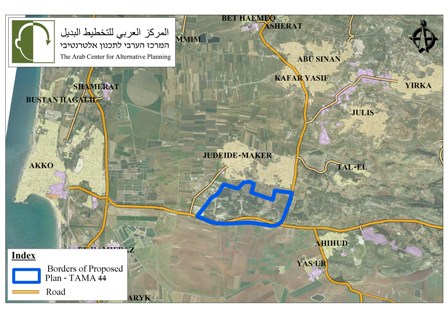Publishing date: 04/08/2011
On May 29, 2011, the Arab Center for Alternative Planning (ACAP) organized a meeting between the oranization’s staff, representatives from the municipality of Jdaide-Maker, including the mayor Mohammad Shami, the owners of land in the Tantoor region, community activists, representative from Adallah, representative from the Kofer Yasef, and other representatives from towns neighboring Jdaide-Maker, and MK Dr. Hanna Swaid. The purpose of the meeting was to discuss the new proposed national plan, TAMA 44 (2,700 dunams) on the land of Tantoor. The plan proposes that the land be converted to an area that can be developed for residential purposes. The plan is currently in the process of discussion in the National Committee for Planning and Building.
Ambiguity Regarding the Plan
ACAP’s urban planner Enaya Banna-Geries opened the meeting with a presentation of the proposed plan and the lack of clarity and transparency regarding it. She stated that the reason for this plan is very ambiguous- sometimes the State representatives claim that they want to develop a new Arab township, while others claim that the proposed plan will create a developmental area. Banna-Geries stated that the aim behind this plan is still unclear; however the process within the National Committee for Land and Planning is quickly progressing.
When the State authorities say that they do not want to establish a new Arab town, they are going against the law. At the same time, they are claiming that they do not want to establish a new Arab town, rather just develop the present area. This confusion and lack of clarity in purpose, as well as the quick speed that they are working to progress the plan, causes us to question the true intentions of the plan and makes it necessary for us to follow-up all details regarding the plan.
The Impact of the Plan on Neighboring Arab Towns
Banna-Geries detailed the impact the plan will have on neighboring Arab towns, including Acco, Jules, Yarka, Abu Sinan, and Kofer Yaseef. The proposed plan indicates that the new area will provide housing and accommodations for citizen’s from these neighboring towns. However, this plan is comprised of private land that was confiscated by the State over 35 years ago from residents of Jdaide-Maker.
The Legal Aspects of Confiscation
In 1976, the State of Israel confiscated a total of 2, 069 dumans of private Arab land according to the law- Confiscation for Public Interest. Of the land confiscated, 34% (or about 700 dunams) was privately owned. Since then, three legal petitions have been submitted requesting that the courts return this private land to their owners due to lack of use for public interest. Among these cases is the issue of the Makhool Family. In 2009, the court ruled that the State must use this confiscated land for the purpose it was confiscated for. If it is not used, it is the legal right of the land owner to demand that this land be returned. In recent years, a new reform of the law has been issued stating that the owner only has 25 years after the land was confiscated to request that it be returned, even if it has not been used for the purpose of confiscation. Representative from Adallah, Advocate Suhad Bishara, confirmed that the State authorities are trying to break the connection between the land owner and his land through the legislation of such laws and reforms. Today, Adallah is working to submit objections against this new reform; however, the results are not guaranteed and the court process may take many years.
Research Implemented by ACAP: Population Density in the New Plan is Equal to Double that in Jewish Towns
Enaya-Banna Geries presented results from a research implemented by ACAP which indicates signs that the planning institutions are seeking to make this new area of housing or new city to be highly populated, with double population density of any other Jewish town or community in the country.
Furthermore, the percent of industrial area per individual in the proposed plan is extremely low, in comparison to Jewish towns. Within this new area of housing in the proposed Tantoor Plan (which is supposed to be a city with modern and sophisticated characteristics), the average ratio of industrial area per citizen is only 4 square meters per citizen, in comparison to 33 square meters per individual in Jewish townships.
The research conducted by ACAP also shows that there is a significant lack of wide open areas in the proposed plan. While the percent of wide open areas remaining for future use/development in Jewish towns is at least 31%, in the proposed Tantoor plan, development and construction is planned for up to 100% of the town; i.e. not even 1 square meter is left open for future development.
ACAP’s professionals concluded by stating that the decision makers of the planning institutions who have led for over decades continue to prevail, and even in the establishment of a new Arab city, fail to take into account the true needs of the Arab citizens.
MK Hanna Swaid expressed no confidence in the proposed plan, especially due to its ambiguity and lack of transparency. He stated that it is the responsibility of the local municipalities to cooperate and work with the public committees to follow-up and monitor the plan in an organized, professional manner.
At the conclusion of the meeting, the different participating representatives agreed on the:
· Seriousness of the proposed plan and the need and importance of closely following-up on all developments
· Necessity of join action and cooperation between the Public Local Committees and the local councils
· Local Council representatives pledged to pursue the proposed plan and designate a professional to closely follow up and monitor the Tantoor plan.
